A Bibliometric and Scientometric Network Analysis of Occupational Safety and Health in the Electric Power Industry: Future Implication of Digital Pathways
Abstract
:1. Introduction
2. Materials and Methods
2.1. Literature Collection
2.2. Scientometric Analysis
2.3. Qualitative Discussion
3. Results
3.1. Descriptive Data Analysis
3.2. Countries/Regions Cooperation Analysis
3.3. Journal Co-Citation Analysis
3.4. Keywords Co-Occurrence Analysis
3.5. Temporal Trend Analysis
4. Discussion
4.1. Emerging Research Topics and Trends
4.1.1. Safety Management: Causes and Prevention
4.1.2. Occupational Exposure in the Electricity Industry
4.1.3. Electrical Incidents Management
4.1.4. Risk Analysis and Management in the Renewable Energy Revolution
4.2. Research Gaps and Future Implications of Digital Pathways
4.2.1. Analysis, Prevention, and Emergency Planning for Electrical Accidents
4.2.2. Hazards in Electric Power Work Environments
4.2.3. Barriers and Facilitators of Safety Climate Improvement
4.2.4. Safety and Health of Renewable Energies
4.3. Research Trends in Occupational Safety and Health in the Electrical Industry
- Strengthening robust emergency preparedness, planning strategies, and effective risk communication strategies.
- Identifying and evaluating strategies that facilitate real-time communication of occupational risks to workers.
- Exploration of the integration of advanced technologies to enhance the accuracy and efficiency of assessing and monitoring occupational risk exposures in the electrical power industry.
- The development of early warning systems to detect and alert workers about potential safety hazards or incidents.
- The enhancement of safety policies and strategies through digital technologies by evaluating their implementation and identifying barriers and facilitators.
- Leveraging real-time monitoring to enhance safety climate.
- The utilization of digital technologies for comprehensive risk analysis and developing targeted risk mitigation strategies.
- Designing digital platforms, interventions and safety training related to the electrical power industry, particularly the renewable energy sector, to enhance workers’ risk perception and safety culture.
5. Conclusions
Funding
Conflicts of Interest
References
- Qu, Z.; Zhang, Z.; Liu, S.; Cao, J.; Bo, X. Knowledge-driven recognition methodology for electricity safety hazard scenarios. Energy Rep. 2022, 8, 10006–10016. [Google Scholar] [CrossRef]
- Rahmani, A.; Khadem, M.; Madreseh, E.; Aghaei, H.A.; Raei, M.; Karchani, M. Descriptive study of occupational accidents and their causes among electricity distribution company workers at an eight-year period in Iran. Saf. Health Work. 2013, 4, 160–165. [Google Scholar] [CrossRef]
- Brenner, B.; Cawley, J.C.; Majano, D. Electrically hazardous jobs in the US. IEEE Trans. Ind. Appl. 2020, 56, 2190–2195. [Google Scholar] [CrossRef]
- Liu, H.C.; Cheng, Y.; Ho, J.J. Associations of ergonomic and psychosocial work hazards with musculoskeletal disorders of specific body parts: A study of general employees in Taiwan. Int. J. Ind. Ergon. 2020, 76, 102935. [Google Scholar] [CrossRef]
- Araújo Vila, N.; Fraiz-Brea, J.A.; Toubes, D.R. Degree of Integration of Risk Preventive Measures in the Management System of Companies in the Electricity Sector. J. Sci. Ind. Res. 2022, 81, 663–670. [Google Scholar] [CrossRef]
- Ugwu, F.I. The effect of workplace safety on the performance of Enugu state electricity distribution company. Eur. J. Financ. Manag. Sci. 2021, 5, 10–27. [Google Scholar]
- Hromada, M.; Rehak, D.; Walker, N. Electricity infrastructure technical security: Practical application and best practices of risk assessment. Saf. Secur. Issues Technol. Infrastruct. 2020, 1–30. [Google Scholar] [CrossRef]
- Rezaei Dizghah, M.; Ajalli, M.; Homayounfar, M. The effect of organizational culture on employees’ safety performance in electricity distribution organization of Gilan Province. Occup. Hygine Health Promot. J. 2022, 6, 98–110. [Google Scholar] [CrossRef]
- Floyd, H.L. A systems safety approach to occupational electrical safety. In Proceedings of the 2014 IEEE-IAS/PCA Cement Industry Technical Conference, Washington, DC, USA, 13–17 April 2014; pp. 1–17. [Google Scholar] [CrossRef]
- Gammon, T.; Lee, W.J.; Intwari, I. Reframing our view of workplace “electrical” injuries. IEEE Trans. Ind. Appl. 2019, 55, 4370–4376. [Google Scholar] [CrossRef]
- Narine, G. Causes and Prevention of Electric Power Industry Accidents: A Delphi Study. Doctoral Dissertation, Walden University, Minneapolis, MN, USA, 2019. Available online: https://www.proquest.com/openview/06e98e9074daf04d39143dda897d4f6f/1?pq-origsite=gscholar&cbl=18750&diss=y (accessed on 19 May 2024).
- Qian, Y.Y.; Xu, J.; Mi, C.M.; Peng, Q.W. Research on electricity falling accident based on improved bode accident causation model. In Smart Service Systems, Operations Management, and Analytics; Yang, H., Qiu, R., Chen, W., Eds.; INFORMS-CSS 2019; Springer Proceedings in Business and Economics; Springer: Cham, Switzerland, 2020. [Google Scholar] [CrossRef]
- Song, Y. Safety management principles in electric power industry based on human factors. In Proceedings of the International Conference on Applied Human Factors and Ergonomics, Orlando, FL, USA, 21–25 July 2018; Springer: Cham, Switzerland, 2018; pp. 541–550. [Google Scholar] [CrossRef]
- Song, Z.; Baicker, K. Effect of a workplace wellness program on employee health and economic outcomes: A randomized clinical trial. JAMA 2019, 321, 1491–1501. [Google Scholar] [CrossRef]
- WHO. Global Strategy on Occupational Health for All: The Way to Health at Work Recommendation of the Second Meeting of the WHO Collaborating Centres in Occupational Health. 1994. Available online: https://www.who.int/publications/i/item/WHO-OCH-95.1 (accessed on 19 May 2024).
- Goetsch, D.L.; Occupational Safety and Health. Pearson India. 2010. Available online: https://www.pearsonhighered.com/assets/preface/0/1/3/4/013469581X.pdf (accessed on 19 May 2024).
- Hosseini, M.R.; Martek, I.; Zavadskas, E.K.; Aibinu, A.A.; Arashpour, M.; Chileshe, N. Critical evaluation of off-site construction research: A Scientometric analysis. Autom. Constr. 2018, 87, 235–247. [Google Scholar] [CrossRef]
- Abedinnia, H.; Glock, C.H.; Schneider, M.D. Machine scheduling in production: A content analysis. Appl. Math. Model. 2017, 50, 279–299. [Google Scholar] [CrossRef]
- Butler, L.; Visser, M.S. Extending citation analysis to non-source items. Scientometrics 2006, 66, 327–343. [Google Scholar] [CrossRef]
- Bastian, M.; Heymann, S.; Jacomy, M. Gephi: An open source software for exploring and manipulating networks. ICWSM 2009, 8, 361–362. [Google Scholar] [CrossRef]
- Waltman, L.; Van Eck, N.J.; Noyons, E.C.M. A unified approach to mapping and clustering of bibliometric networks. J. Informetr. 2010, 4, 629–635. [Google Scholar] [CrossRef]
- Waltman, L.; Van Eck, N.J. A new methodology for constructing a publication-level classification system of science. J. Am. Soc. Inf. Sci. 2012, 63, 2378–2392. [Google Scholar] [CrossRef]
- Esen, M.; Bellibas, M.S.; Gumus, S. The evolution of leadership research in higher education for two decades (1995–2014): A bibliometric and content analysis. Int. J. Leadersh. Educ. 2020, 23, 259–273. [Google Scholar] [CrossRef]
- Prell, C. Social Network Analysis: History, Theory and Methodology; Sage: Southern Oaks, CA, USA, 2012. [Google Scholar]
- Chen, C.; Ao, Y.; Wang, Y.; Li, J. Performance appraisal method for rural infrastructure construction based on public satisfaction. PLoS ONE 2018, 13, e0204563. [Google Scholar] [CrossRef]
- Feng, S.; Hu, B.; Nie, C.; Shen, X. Empirical study on a directed and weighted bus transport network in China. Phys. A Stat. Mech. Its Appl. 2016, 441, 85–92. [Google Scholar] [CrossRef]
- De Nooy, W.; Mrvar, A.; Batagelj, V. Exploratory Social Network Analysis with Pajek; Cambridge University Press: Cambridge, UK, 2005. [Google Scholar]
- Lombardi, M.; Fargnoli, M.; Parise, G. Risk profiling from the european statistics on accidents at work (ESAW) accidents’ databases: A case study in construction sites. Int. J. Environ. Res. Public Health 2019, 16, 4748. [Google Scholar] [CrossRef]
- Wong, F.; Chan, A.; Wong, A.; Hon, C.; Choi, T. Accidents of electrical and mechanical works for public sector projects in Hong Kong. Int. J. Environ. Res. Public Health 2018, 15, 485. [Google Scholar] [CrossRef]
- Basahel, A.M. Safety leadership, safety attitudes, safety knowledge and motivation toward safety-related behaviors in electrical substation construction projects. Int. J. Environ. Res. Public Health 2021, 18, 4196. [Google Scholar] [CrossRef]
- Chen, Y.; Feng, W.; Jiang, Z.; Duan, L.; Cheng, S. An accident causation model based on safety information cognition and its application. Reliab. Eng. Syst. Saf. 2021, 27, 107363. [Google Scholar] [CrossRef]
- Khan, R.U.; Yin, J.; Mustafa, F.S.; Ahmad Farea, A.O. A data centered human factor analysis approach for hazardous cargo accidents in a port environment. J. Loss Prev. Process Ind. 2022, 75, 104711. [Google Scholar] [CrossRef]
- Oliver, A.; Cheyne, A.; Tomás, J.M.; Cox, S. The effects of organizational and individual factors on occupational accidents. J. Occup. Organ. Psychol. 2002, 75, 473–488. [Google Scholar] [CrossRef]
- Li, G.; Yang, H.-X.; Yuan, C.-M.; Eckhoff, R.K. A catastrophic aluminium-alloy dust explosion in China. J. Loss Prev. Process Ind. 2016, 39, 121–130. [Google Scholar] [CrossRef]
- Randeberg, E.; Eckhoff, R.K. Initiation of dust explosions by electric spark discharges triggered by the explosive dust cloud itself. J. Loss Prev. Process Ind. 2006, 19, 154–160. [Google Scholar] [CrossRef]
- Yuan, Z.; Khakzad, N.; Khan, F.; Amyotte, P. Dust explosions: A threat to the process industries. Process Saf. Environ. Prot. 2015, 98, 57–71. [Google Scholar] [CrossRef]
- Ji, M.; Sun, Z.; Guo, H. The application of the foam technology to the dust control for reducing the dust injury of coal mines. Appl. Sci. 2022, 12, 10878. [Google Scholar] [CrossRef]
- Man, C.K.; Harris, M.L. Participation of large particles in coal dust explosions. J. Loss Prev. Process Ind. 2014, 27, 49–54. [Google Scholar] [CrossRef]
- Pak, S.; Jung, S.; Roh, C.; Kang, C. Case studies for dangerous dust explosions in South Korea during recent years. Sustainability 2019, 11, 4888. [Google Scholar] [CrossRef]
- Wei, M.C.; Cheng, Y.C.; Lin, Y.Y.; Kuo, W.K.; Shu, C.M. Applications of dust explosion hazard and disaster prevention technology. J. Loss Prev. Process Ind. 2020, 68, 104304. [Google Scholar] [CrossRef]
- Flouris, A.D.; Ioannou, L.G.; Notley, S.R.; Kenny, G.P. Determinants of heat stress and strain in electrical utilities workers across North America as assessed by means of an exploratory questionnaire. J. Occup. Environ. Hyg. 2022, 19, 12–22. [Google Scholar] [CrossRef]
- Spector, J.T.; Sheffield, P.E. Re-evaluating occupational heat stress in a changing climate. Ann. Occup. Hyg. 2014, 58, 936–942. [Google Scholar] [CrossRef]
- Janackovic, G.; Stojiljkovic, E.; Grozdanovic, M. Selection of key indicators for the improvement of occupational safety system in electricity distribution companies. Saf. Sci. 2020, 125, 103654. [Google Scholar] [CrossRef]
- Seeley, P.A.; Marklin, R.W. Business case for implementing two ergonomic interventions at an electric power utility. Appl. Ergon. 2003, 34, 429–439. [Google Scholar] [CrossRef]
- Zwetsloot, G.; Leka, S.; Kines, P.; Jain, A. Vision zero: Developing proactive leading indicators for safety, health and wellbeing at work. Saf. Sci. 2020, 130, 104890. [Google Scholar] [CrossRef]
- Hartwig, V.; Virgili, G.; Ederica Mattei, F.; Biagini, C.; Romeo, S.; Zeni, O.; Scarfì, M.R.; Massa, R.; Campanella, F.; Landini, L.; et al. Occupational exposure to electromagnetic fields in magnetic resonance environment: An update on regulation, exposure assessment techniques, health risk evaluation, and surveillance. Med. Biol. Eng. Comput. 2022, 60, 297–320. [Google Scholar] [CrossRef]
- Serafeim, I.; Apostolidis, C.; Athanasios, M.; Samaras, T. Electromagnetic fields exposure assessment in Europe utilizing publicly available data. Sensors 2022, 22, 8481. [Google Scholar] [CrossRef]
- Politański, P.; Aniołczyk, H.; Gadzicka, E.; Bortkiewicz, A.; Zmyślony, M. Electromagnetic fields exposure assessment among workers at broadcast centers in Poland. Med. Pr. 2018, 69, 477–482. [Google Scholar] [CrossRef]
- Vila, J.; Turner, M.C.; Gracia-Lavedan, E.; Figuerola, J.; Bowman, J.D.; Kincl, L.; Richardson, L.; Benke, G.; Hours, M.; Krewski, D.; et al. Occupational exposure to high-frequency electromagnetic fields and brain tumor risk in the INTEROCC study: An individualized assessment approach. Environ. Int. 2018, 119, 353–365. [Google Scholar] [CrossRef]
- Carpenter, D.O. Extremely low frequency electromagnetic fields and cancer: How source of funding affects results. Environ. Res. 2019, 178, 108688. [Google Scholar] [CrossRef]
- Rodrigues, N.C.P.; Dode, A.C.; de Noronha Andrade, M.K.; O’Dwyer, G.; Monteiro, D.L.M.; Reis, I.N.C.; Rodrigues, R.P.; Frossard, V.C.; Lino, V.T.S. The effect of continuous low-intensity exposure to electromagnetic fields from radio base stations to cancer mortality in Brazil. Int. J. Environ. Res. Public Health 2021, 18, 1229. [Google Scholar] [CrossRef]
- Sorahan, T.M. Cancer incidence in UK electricity generation and transmission workers, 1973–2015. Occup. Med. 2019, 69, 342–351. [Google Scholar] [CrossRef]
- Jalilian, H.; Teshnizi, S.H.; Röösli, M.; Neghab, M. Occupational exposure to extremely low frequency magnetic fields and risk of Alzheimer disease: A systematic review and meta-analysis. Neurotoxicology 2018, 69, 242–252. [Google Scholar] [CrossRef]
- Baaken, D.; Dechent, D.; Blettner, M.; Drießen, S.; Merzenich, H. Occupational exposure to extremely low-frequency magnetic fields and risk of amyotrophic lateral sclerosis: Results of a feasibility study for a pooled analysis of original data. Bioelectromagnetics 2021, 42, 271–283. [Google Scholar] [CrossRef]
- Huss, A.; Peters, S.; Vermeulen, R. Occupational exposure to extremely low-frequency magnetic fields and the risk of ALS: A systematic review and meta-analysis. Bioelectromagnetics 2018, 39, 156–163. [Google Scholar] [CrossRef]
- Jalilian, H.; Najafi, K.; Khosravi, Y.; Röösli, M. Amyotrophic lateral sclerosis, occupational exposure to extremely low-frequency magnetic fields and electric shocks: A systematic review and meta-analysis. Rev. Environ. Health 2020, 36, 129–142. [Google Scholar] [CrossRef]
- Pavlík, M.; Melnykov, V. Measurement of Reflection and Shielding Effectiveness of Electromagnetic Fields in Construction Materials with Subsequent Calculation of Absorption. In Proceedings of the IEEE 5th International Conference on Modern Electrical and Energy System (MEES), Kremenchuk, Ukraine, 27–30 September 2023; pp. 1–4. [Google Scholar]
- Bracken, T.D.; Patterson, R.M. Variability and consistency of electric and magnetic field occupational exposure measurements. J. Expo. Anal. Environ. Epidemiol. 1996, 6, 355–374. [Google Scholar]
- Mohammadyan, M.; Moosazadeh, M.; Borji, A.; Khanjani, N.; Rahimi Moghadam, S. Investigation of occupational exposure to lead and its relation with blood lead levels in electrical solderers. Environ. Monit. Assess. 2019, 191, 126. [Google Scholar] [CrossRef]
- Mild, K.H.; Alanko, T.; Decat, G.; Falsaperla, R.; Gryz, K.; Hietanen, M.; Karpowicz, J.; Rossi, P.; Sandström, M. Exposure of workers to electromagnetic fields. A review of open questions on exposure assessment techniques. Int. J. Occup. Saf. Ergon. 2009, 15, 3–33. [Google Scholar] [CrossRef] [PubMed]
- Modenese, A.; Gobba, F. Occupational exposure to electromagnetic fields and health surveillance according to the European Directive 2013/35/EU. Int. J. Environ. Res. Public Health 2021, 18, 1730. [Google Scholar] [CrossRef] [PubMed]
- Biering, K.; Vestergaard, J.M.; Nielsen, K.J. Contacts with general practitioner, sick leave and work participation after electrical injuries: A register-based, matched cohort study. Occup. Environ. Med. 2021, 78, 54–60. [Google Scholar] [CrossRef] [PubMed]
- Dechent, D.; Emonds, T.; Stunder, D.; Schmiedchen, K.; Kraus, T.; Driessen, S. Direct current electrical injuries: A systematic review of case reports and case series. Burns 2020, 46, 267–278. [Google Scholar] [CrossRef] [PubMed]
- Fordyce, T.A.; Kelsh, M.; Lu, E.T.; Sahl, J.D.; Yager, J.W. Thermal burn and electrical injuries among electric utility workers, 1995–2004. Burns 2007, 33, 209–220. [Google Scholar] [CrossRef] [PubMed]
- Ichikawa, N. Electrical injury rate and epidemiology in Japan, 2013–2015. IEEE Trans. Ind. Appl. 2020, 56, 4319–4323. [Google Scholar] [CrossRef]
- Koumbourlis, A.C. Electrical injuries. Crit. Care Med. 2002, 30, S424–S430. [Google Scholar] [CrossRef] [PubMed]
- Waldmann, V.; Narayanan, K.; Combes, N.; Jost, D.; Jouven, X.; Marijon, E. Electrical cardiac injuries: Current concepts and management. Eur. Heart J. 2018, 39, 1459–1465. [Google Scholar] [CrossRef] [PubMed]
- Liu, S.; Yu, Y.; Huang, Q.; Luo, B.; Liao, X. Electrocution-related mortality: A review of 71 deaths by low-voltage electrical current in Guangdong, China, 2001–2010. Am. J. Forensic Med. Pathol. 2014, 35, 193–196. [Google Scholar] [CrossRef]
- Massey, B.K.; Sait, M.A.; Johnson, W.L.; Ripple, M.; Fowler, D.R.; Li, L. Deaths due to electrocution: An evaluation of death scene investigations and autopsy findings. J. Forensic Sci. Med. 2018, 4, 179–183. [Google Scholar] [CrossRef]
- Arnoldo, B.D.; Purdue, G.F.; Kowalske, K.; Helm, P.A.; Burris, A.; Hunt, J.L. Electrical injuries: A 20-year review. J. Burn Care Rehabil. 2004, 25, 479–484. [Google Scholar] [CrossRef] [PubMed]
- Rabban, J.T.; Blair, J.A.; Rosen, C.L.; Adler, J.N.; Sheridan, R.L. Mechanisms of pediatric electrical injury. New implications for product safety and injury prevention. Arch. Pediatr. Adolesc. Med. 1997, 151, 696–700. [Google Scholar] [CrossRef] [PubMed]
- Mebarki, B.; Bengharbi, M.; Mokdad, M.; Bouabdellah, L. Burning and electrocution risk’s evaluation and prevention procedures: A case study in a production work shop. In Advances in Safety Management and Human Factors. AHFE 2017. Advances in Intelligent Systems and Computing; Arezes, P., Ed.; Springer: Cham, Switzerland, 2018; Volume 604. [Google Scholar] [CrossRef]
- Garcia, D.; Bruschi, D. A risk assessment tool for improving safety standards and emergency management in Italian onshore wind farms. Sustain. Energy Technol. Assess. 2016, 18, 48–58. [Google Scholar] [CrossRef]
- Mulloy, K.B.; Sumner, S.A.; Rose, C.; Conway, G.A.; Reynolds, S.J.; Davidson, M.E.; Heidel, D.S.; Layde, P.M. Renewable energy and occupational health and safety research directions: A white paper from the Energy Summit, Denver Colorado, April 11–13, 2011. Am. J. Ind. Med. 2013, 56, 1359–1370. [Google Scholar] [CrossRef] [PubMed]
- Gerassis, S.; Abad, A.; Giráldez, E.; Taboada, J. The impact of renewable energy for occupational health in the smart grid era. J. Clean Energy Technol. 2018, 6, 405–410. [Google Scholar] [CrossRef]
- Dhar, A.; Naeth, M.A.; Jennings, P.D.; El-Din, M.G. Geothermal energy resources: Potential environmental impact and land reclamation. Environ. Rev. 2020, 28, 415–427. [Google Scholar] [CrossRef]
- Qin, Z.; Zhuang, Q.; Cai, X.; He, Y.; Huang, Y.; Jiang, D.; Lin, E.; Liu, Y.; Tang, Y.; Wang, M.Q. Biomass and biofuels in China: Toward bioenergy resource potentials and their impacts on the environment. Renew. Sustain. Energy Rev. 2018, 82, 2387–2400. [Google Scholar] [CrossRef]
- Wu, Y.; Zhao, F.; Liu, S.; Wang, L.; Qiu, L.; Alexandrov, G.; Jothiprakash, V. Bioenergy production and environmental impacts. Geosci. Lett 2018, 5, 14. [Google Scholar] [CrossRef]
- Al-Shetwi, A.Q. Sustainable development of renewable energy integrated power sector: Trends, environmental impacts, and recent challenges. Sci. Total Environ. 2022, 822, 153645. [Google Scholar] [CrossRef]
- Sui, Y.; Ding, R.; Wang, H. A novel approach for occupational health and safety and environment risk assessment for nuclear power plant construction project. J. Clean. Prod. 2020, 258, 120945. [Google Scholar] [CrossRef]
- Mohandes, S.R.; Zhang, X. Developing a holistic occupational health and safety risk assessment model: An application to a case of sustainable construction project. J. Clean. Prod. 2021, 291, 125934. [Google Scholar] [CrossRef]
- Rantala, M.; Lindholm, M.; Tappura, S. Supporting occupational health and safety risk assessment skills: A case study of five companies. Int. J. Environ. Res. Public Health 2022, 19, 1720. [Google Scholar] [CrossRef] [PubMed]
- Mu, R.; Zuo, J.; Yuan, X. China’s approach to nuclear safety—From the perspective of policy and institutional system. Energy Policy 2015, 76, 161–172. [Google Scholar] [CrossRef]
- Wada, K.; Yoshikawa, T.; Hayashi, T.; Aizawa, Y. Emergency response technical work at Fukushima Dai-ichi nuclear power plant: Occupational health challenges posed by the nuclear disaster. Occup. Environ. Med. 2012, 69, 599–602. [Google Scholar] [CrossRef] [PubMed]
- Heo, G.; Park, J. A framework for evaluating the effects of maintenance-related human errors in nuclear power plants. Reliab. Eng. Syst. Saf. 2010, 95, 797–805. [Google Scholar] [CrossRef]
- Jeong, K.; Choi, B.; Moon, J.; Hyun, D.; Lee, J.; Kim, I.; Kim, G.; Kang, S. Risk assessment on abnormal accidents from human errors during decommissioning of nuclear facilities. Ann. Nucl. Energy 2016, 87, 1–6. [Google Scholar] [CrossRef]
- Suh, Y.A.; Yim, M.S. A worker’s fitness-for-duty status identification based on biosignals to reduce human error in nuclear power plants. Nucl. Technol. 2020, 206, 1840–1860. [Google Scholar] [CrossRef]
- Sovacool, B.K. A critical evaluation of nuclear power and renewable electricity in Asia. J. Contemp. Asia. 2010, 40, 369–400. [Google Scholar] [CrossRef]
- Zhang, T.; Liu, Z.; Zheng, S.; Qu, X.; Tao, D. Predicting errors, violations, and safety participation behavior at nuclear power plants. Int. J. Environ. Res. Public Health. 2020, 17, 5613. [Google Scholar] [CrossRef]
- Tao, D.; Liu, Z.; Diao, X.; Tan, H.; Qu, X.; Zhang, T. Antecedents of self-reported safety behaviors among commissioning workers in nuclear power plants: The roles of demographics, personality traits and safety attitudes. Nucl. Eng. Technol. 2021, 53, 1454–1463. [Google Scholar] [CrossRef]
- Shimura, T.; Yamaguchi, I.; Terada, H.; Robert Svendsen, E.; Kunugita, N. Public health activities for mitigation of radiation exposures and risk communication challenges after the Fukushima nuclear accident. J. Radiat. Res. 2015, 56, 422–429. [Google Scholar] [CrossRef] [PubMed]
- Ding, H.; Huang, M.; Li, D.; Lin, Y.; Qian, W. Epidemiology of electrical burns: A 10-year retrospective analysis of 376 cases at a burn centre in South China. J. Int. Med. Res. 2019, 48, 300060519891325. [Google Scholar] [CrossRef] [PubMed]
- Simon, T.; Goldberg, A.; Adini, B. Socializing in emergencies—A review of the use of social media in emergency situations. Int J. Inf. Manag. 2015, 35, 609–619. [Google Scholar] [CrossRef]
- Sadeghain, M.; Farid, R.A.; Dormohammadi, A.; Aghaei, H.A.; Rahmani, A.; Farhadi, R.; Eskandari, R.; Karchani, M. Assessment of the prevalence of occupational accidents and their influential actors in an electricity distribution company during a five-year period. Electron. Physician 2013, 5, 643–650. [Google Scholar] [CrossRef] [PubMed]
- Noreen, U.; Ahmed, Z.; Khalid, A.; Di Serafino, A.; Habiba, U.; Ali, F.; Hussain, M. Water pollution and occupational health hazards caused by the marble industries in district Mardan, Pakistan. Environ. Technol. Innov. 2019, 16, 100470. [Google Scholar] [CrossRef]
- Wang, B.; Dehghanian, P.; Wang, S.; Mitolo, M. Electrical safety considerations in large-scale electric vehicle charging stations. IEEE Trans. Ind. Appl. 2019, 55, 6603–6612. [Google Scholar] [CrossRef]
- Bakhiyi, B.; Labrèche, F.; Zayed, J. The photovoltaic industry on the path to a sustainable future—Environmental and occupational health issues. Environ. Int. 2014, 73, 224–234. [Google Scholar] [CrossRef] [PubMed]
- Karanikas, N.; Steele, S.; Bruschi, K.; Robertson, C.; Kass, J.; Popovich, A.; MacFadyen, C. Occupational health hazards and risks in the wind industry. Energy Rep. 2021, 7, 3750–3759. [Google Scholar] [CrossRef]
- Wiss, J.; Fleury, C.; Onken, U. Safety improvement of chemical processes involving azides by online monitoring of the hydrazoic acid concentration. Org. Process Res. Dev. 2006, 10, 349–353. [Google Scholar] [CrossRef]
- Jiang, S.W.; Chen, S.Y.; Chen, W.E.; Wu, H.T. Development of personnel epidemic prevention monitoring access control system. In International Computer Symposium; Springer Nature: Singapore, 2022; pp. 223–229. [Google Scholar]
- Da Xu, L.; He, W.; Li, S. Internet of things in industries: A survey. IEEE Trans Ind Inform. 2014, 10, 2233–2243. [Google Scholar] [CrossRef]
- Nikulin, A.; Ikonnikov, D.; Dolzhikov, I. Smart personal protective equipment in the coal mining industry. Int. J. Civ. Eng. Technol. 2019, 10, 852–863. [Google Scholar]
- Acar, E.; Wall, J.; McNamee, F.; Carney, M.; Öney-Yazici, E. Innovative safety management training through e-learning. Archit. Eng. Des. Manag. 2008, 4, 239–250. [Google Scholar] [CrossRef]
- Yule, S.; Flin, R.; Murdy, A. The role of management and safety climate in preventing risk-taking at work. Int. J. Risk Assess. Manag. 2007, 7, 137. [Google Scholar] [CrossRef]
- Dollard, M.F.; McTernan, W. Psychosocial safety climate: A multilevel theory of work stress in the health and community service sector. Epidemiol. Psychiatr. Sci. 2011, 20, 287–293. [Google Scholar] [CrossRef]
- Omidi, L.; Karimi, H.; Pilbeam, C.; Mousavi, S.; Moradi, G. Exploring the relationships among safety leadership, safety climate, psychological contract of safety, risk perception, safety compliance, and safety outcomes. Front. Public Health 2023, 11, 1235214. [Google Scholar] [CrossRef]
- Fugas, C.S.; Silva, S.A.; Meliá, J.L. Another look at safety climate and safety behavior: Deepening the cognitive and social mediator mechanisms. Accid. Anal. Prev. 2012, 45, 468–477. [Google Scholar] [CrossRef]
- Bronkhorst, B.; Tummers, L.; Steijn, B. Improving safety climate and behavior through a multifaceted intervention: Results from a field experiment. Saf. Sci. 2018, 103, 293–304. [Google Scholar] [CrossRef]
- Volberg, V.; Fordyce, T.; Leonhard, M.; Mezei, G.; Vergara, X.; Krishen, L. Injuries among electric power industry workers, 1995–2013. J. Safety Res. 2017, 60, 9–16. [Google Scholar] [CrossRef]
- Roberts, D.T. Applying Risk Assessment at the Worker Level: Applications to Electrical Safety. IEEE Ind. Appl. Mag. 2019, 25, 18–24. [Google Scholar] [CrossRef]
- Li, R.; Chen, Y.; Ritchie, M.D.; Moore, J.H. Electronic health records and polygenic risk scores for predicting disease risk. Nat. Rev. Genet. 2020, 21, 493–502. [Google Scholar] [CrossRef]
- Vukićević, A.M.; Mačužić, I.; Djapan, M.; Milićević, V.; Shamina, L. Digital training and advanced learning in occupational safety and health based on modern and affordable technologies. Sustainability 2021, 13, 13641. [Google Scholar] [CrossRef]
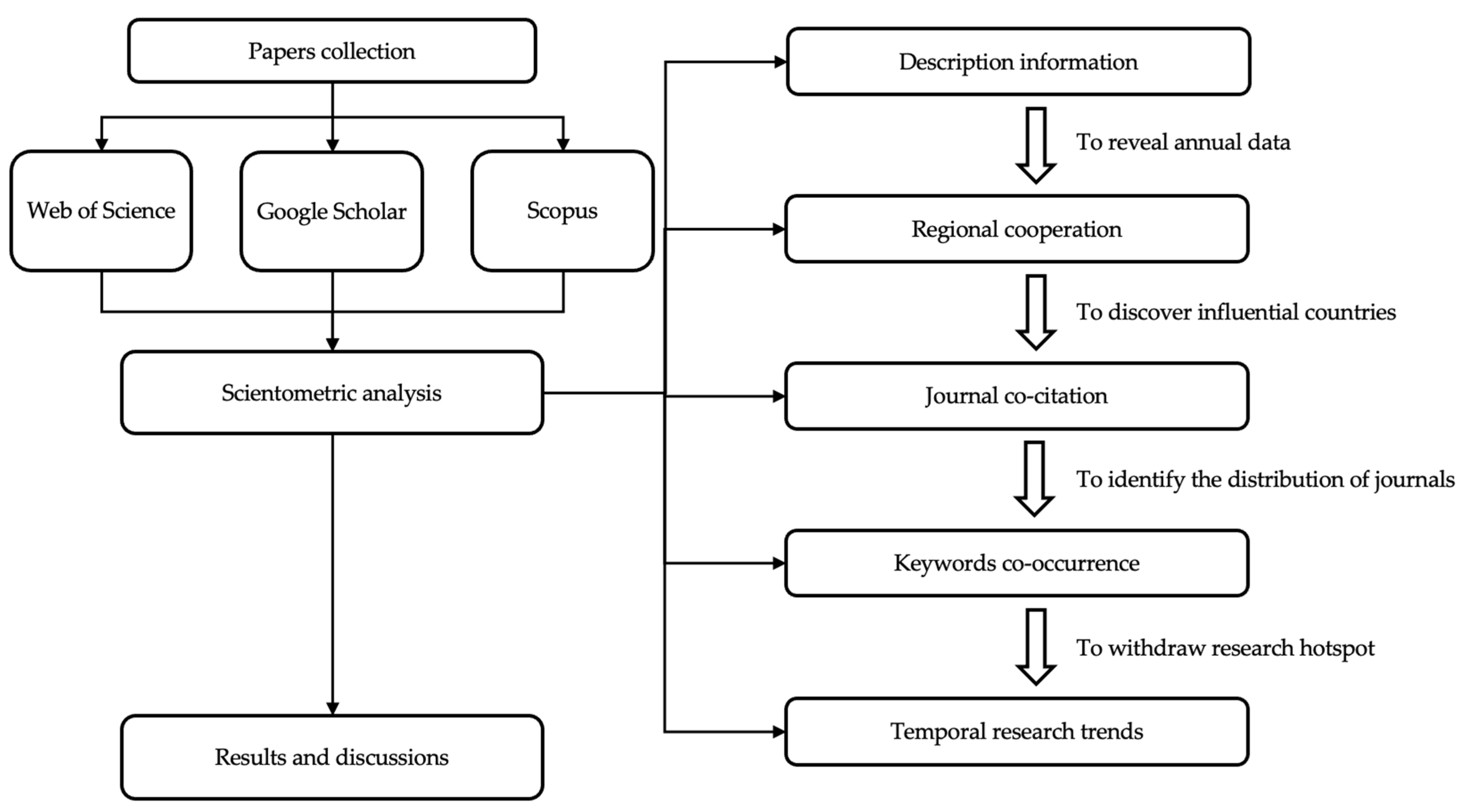
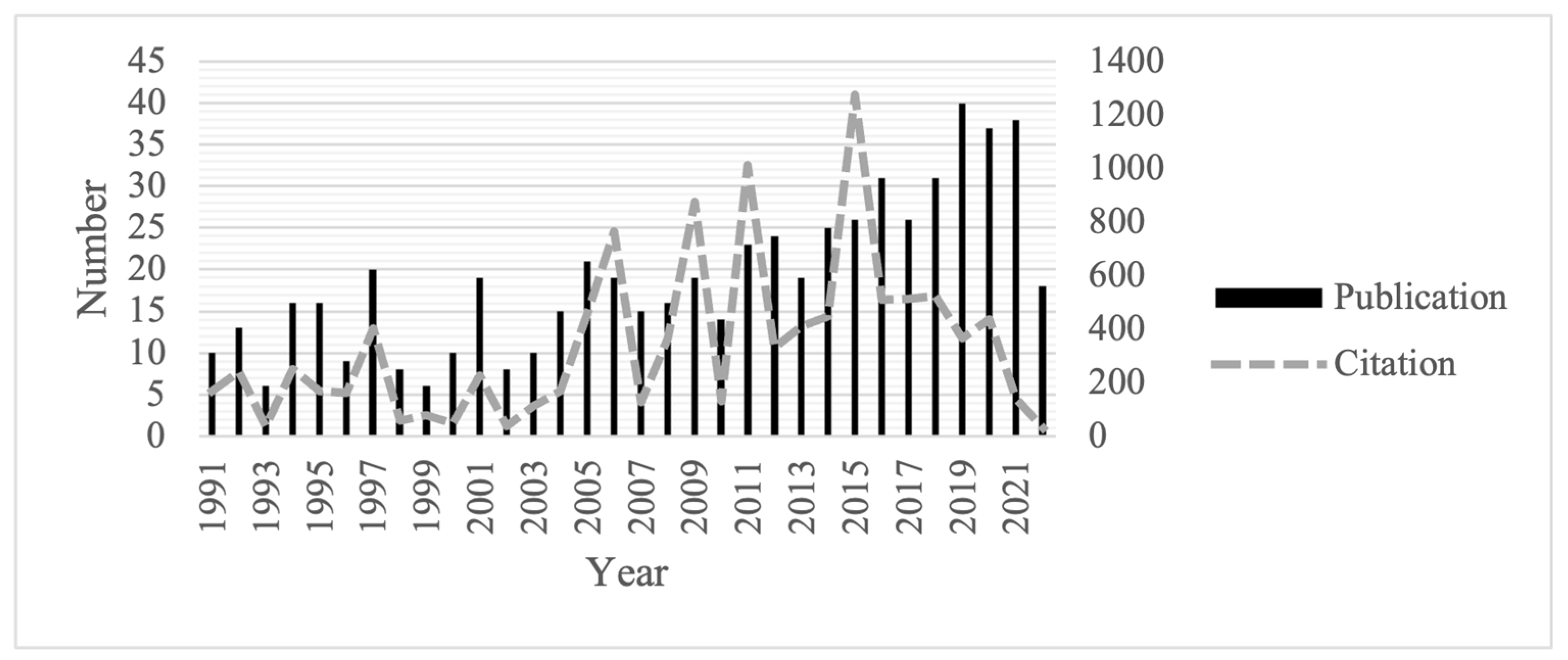

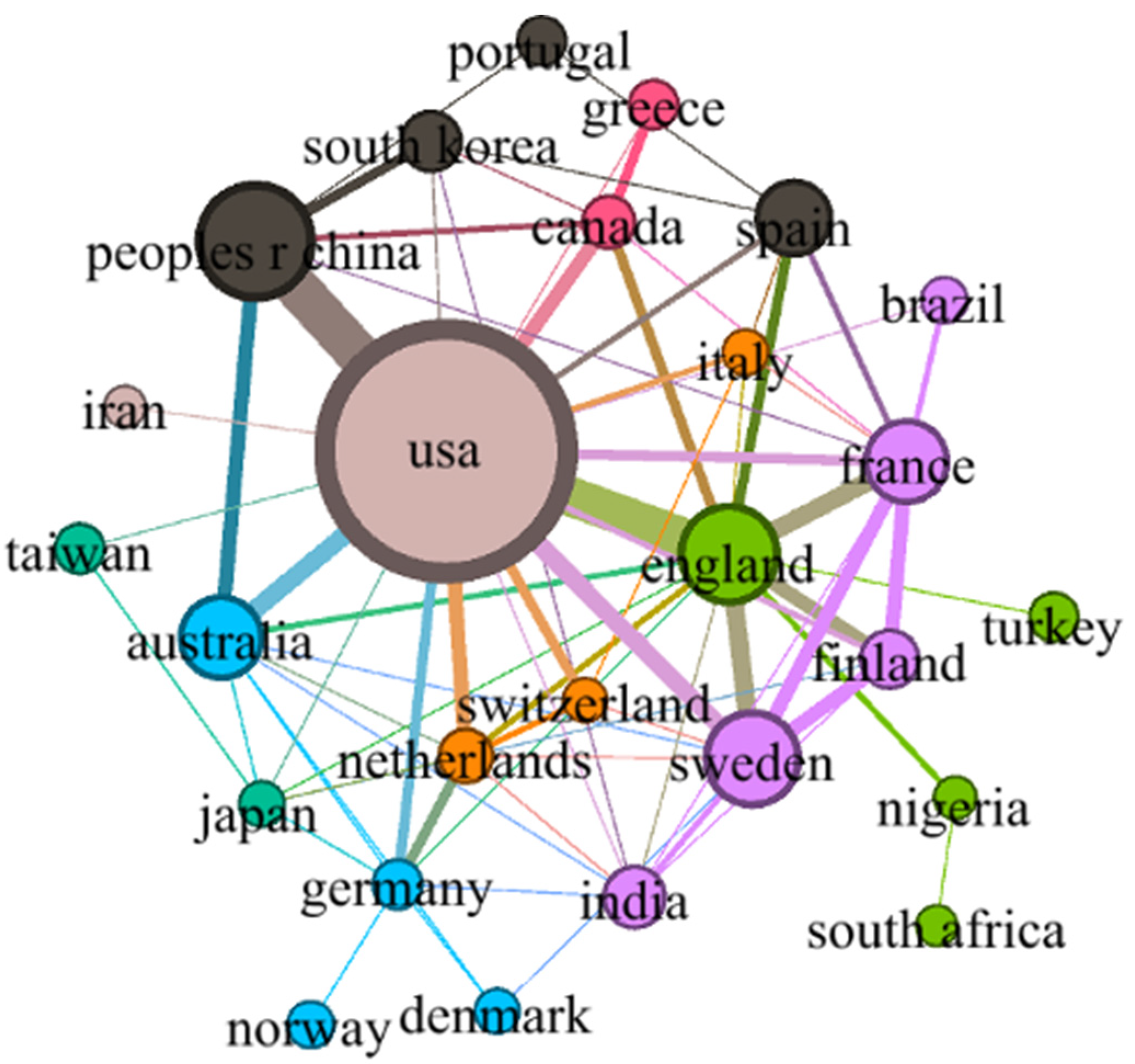


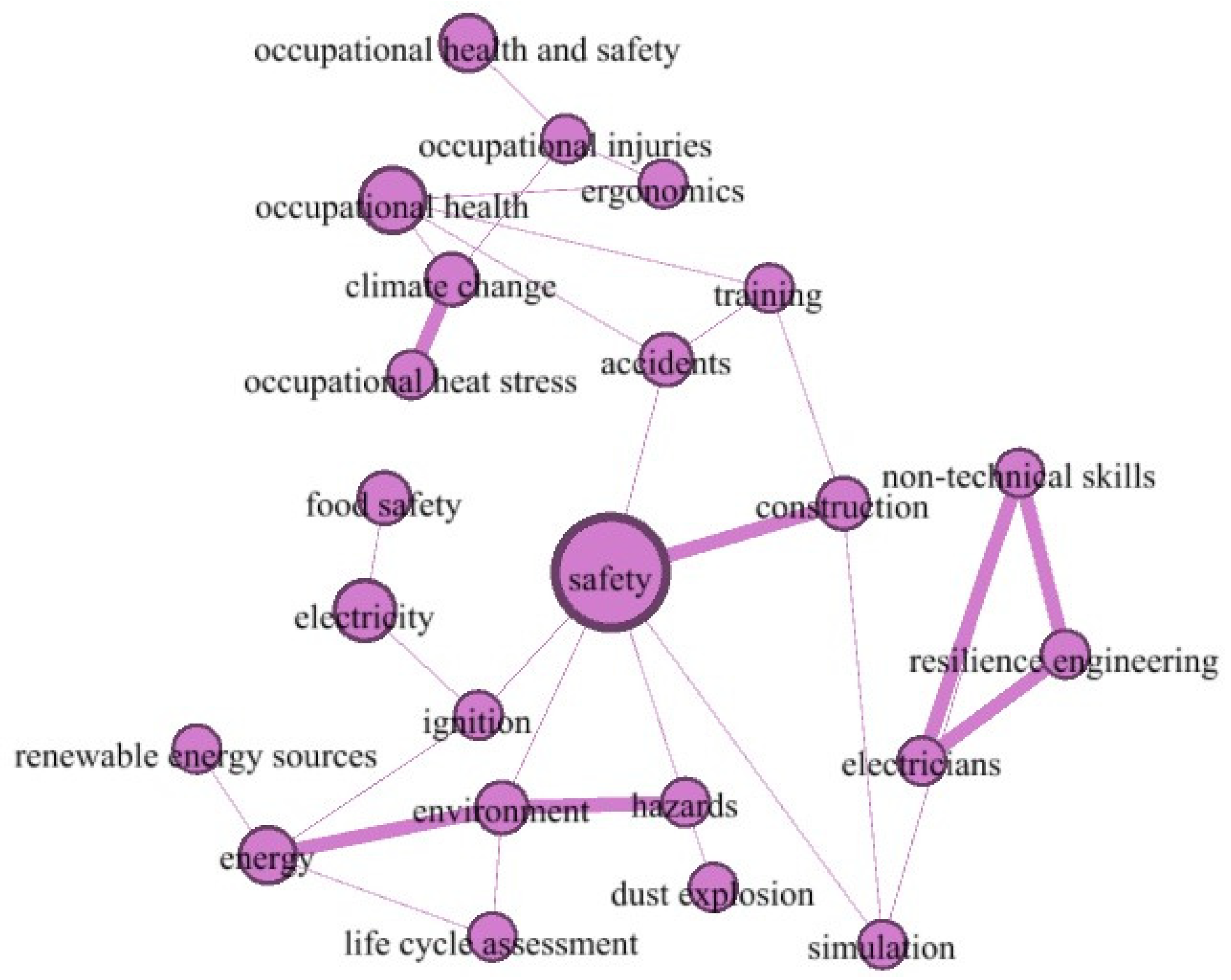
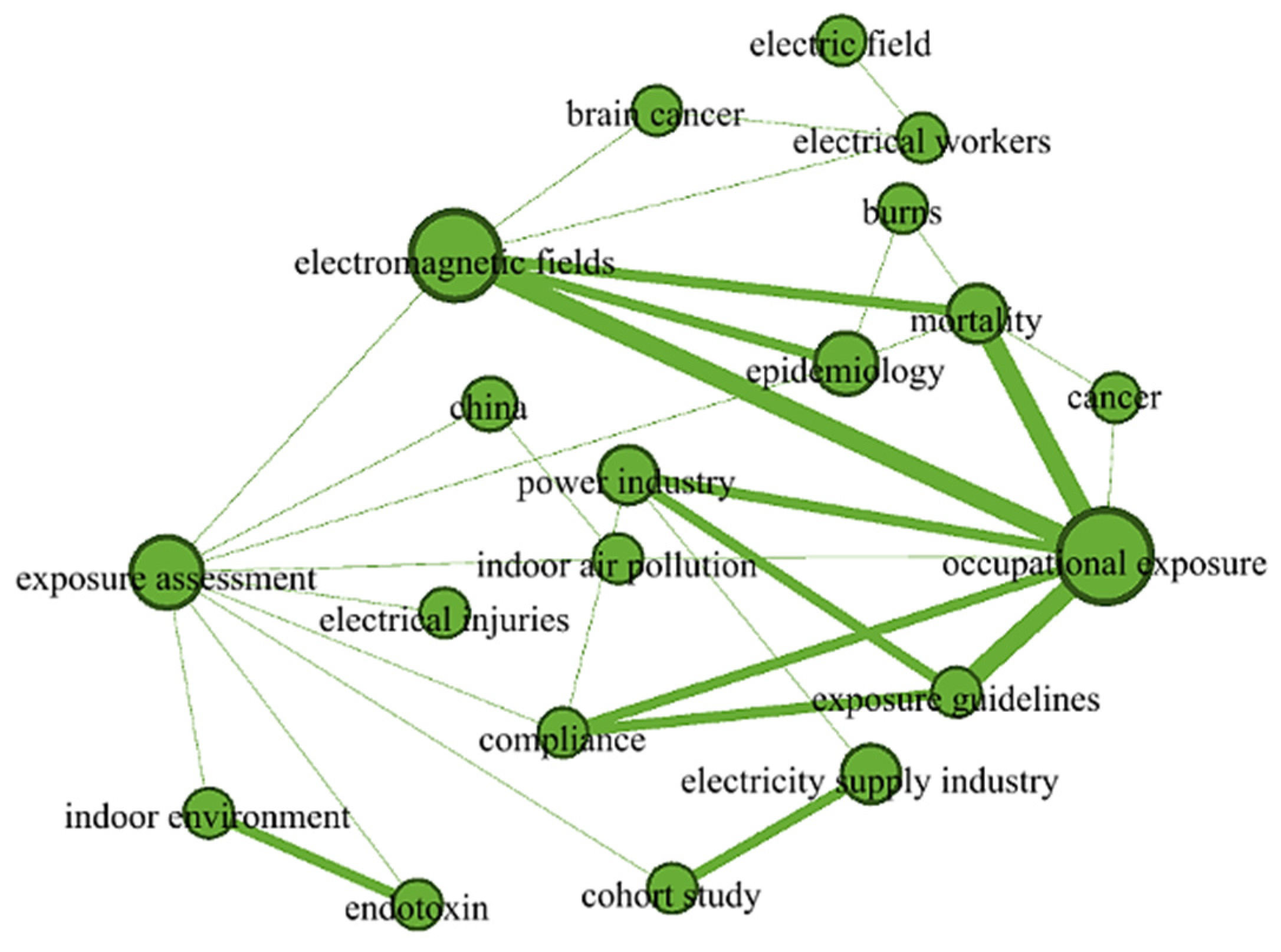
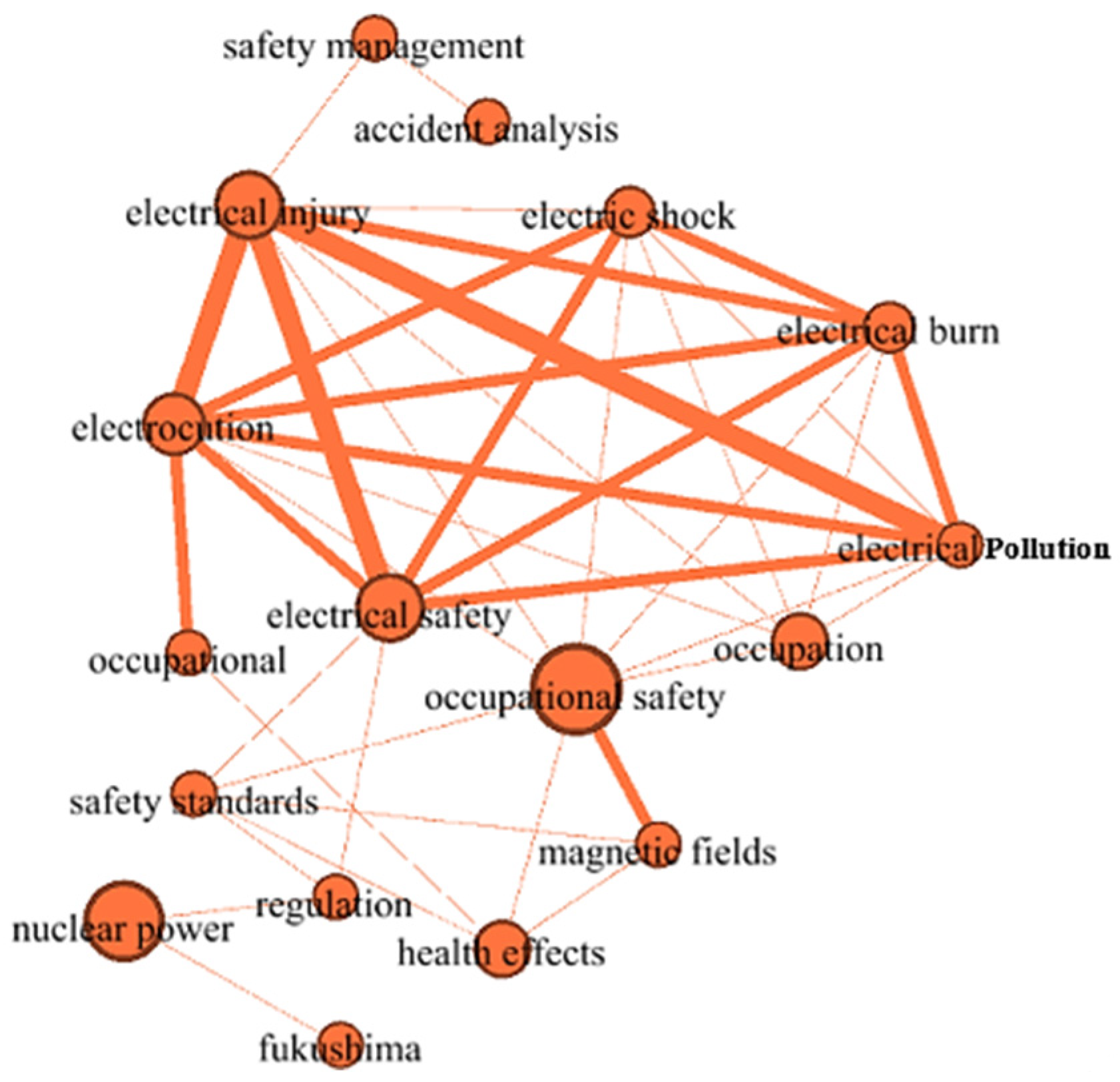

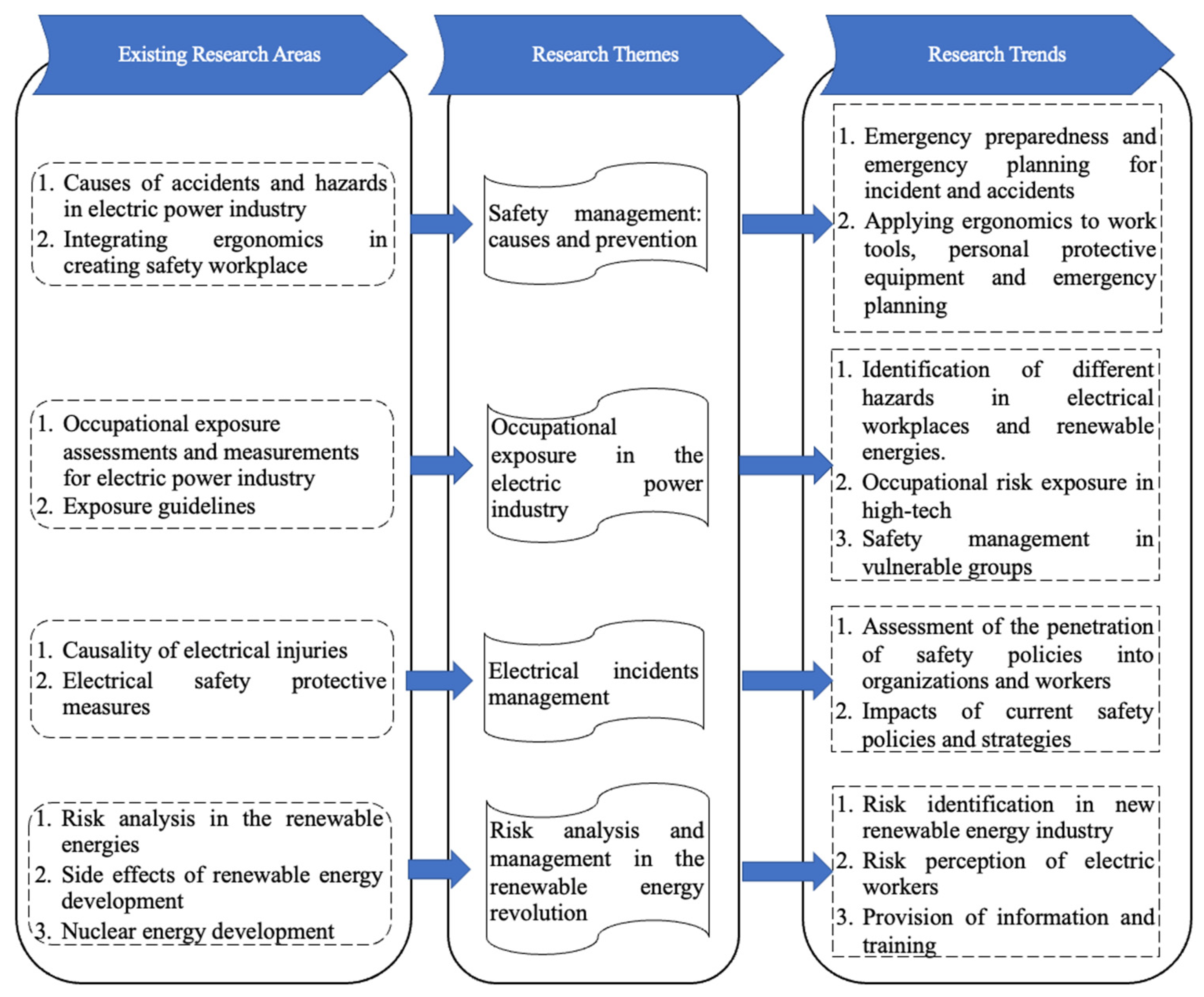
| Name of Journal | Impact Factor (2021) | Global Citation | Weighted Link Strength |
|---|---|---|---|
| International Journal of Environmental Research and Public Health | 4.614 | 168 | 10 |
| Safety Science | 6.392 | 694 | 8 |
| American Journal of Industrial Medicine | 2.214 | 165 | 8 |
| Occupational And Environmental Medicine | 4.948 | 460 | 5 |
| Journal of Occupational and Environmental Hygiene | 3.359 | 264 | 5 |
| IEEE Transactions on Industry Applications | 4.079 | 190 | 5 |
| Journal of Safety Research | 4.264 | 124 | 4 |
| Work-A Journal of Prevention Assessment & Rehabilitation | 1.169 | 34 | 4 |
| Journal of Cleaner Production | 11.07 | 352 | 2 |
| Energy | 8.857 | 26 | 2 |
| Keywords | Strength | Start Year | End Year | Burstiness (from 1991 to 2022) |
|---|---|---|---|---|
| Safety | 10 | 1991 | 2000 | ▃▃▃▃▃▃▃▃▃▃▂▂▂▂▂▂▂▂▂▂▂▂▂▂▂▂▂▂▂▂▂▂ |
| Electrician | 3 | 2001 | 2003 | ▂▂▂▂▂▂▂▂▂▂▃▃▃▂▂▂▂▂▂▂▂▂▂▂▂▂▂▂▂▂▂▂ |
| Occupational heat stress | 1 | 2004 | 2004 | ▂▂▂▂▂▂▂▂▂▂▂▂▂▃▂▂▂▂▂▂▂▂▂▂▂▂▂▂▂▂▂▂ |
| Ignition | 3 | 2005 | 2007 | ▂▂▂▂▂▂▂▂▂▂▂▂▂▂▃▃▃▂▂▂▂▂▂▂▂▂▂▂▂▂▂▂ |
| Dust explosion | 1 | 2008 | 2008 | ▂▂▂▂▂▂▂▂▂▂▂▂▂▂▂▂▂▃▂▂▂▂▂▂▂▂▂▂▂▂▂▂ |
| Ergonomic | 2 | 2009 | 2010 | ▂▂▂▂▂▂▂▂▂▂▂▂▂▂▂▂▂▂▃▃▂▂▂▂▂▂▂▂▂▂▂▂ |
| Simulation | 3 | 2011 | 2013 | ▂▂▂▂▂▂▂▂▂▂▂▂▂▂▂▂▂▂▂▂▃▃▃▂▂▂▂▂▂▂▂▂ |
| Training | 5 | 2014 | 2018 | ▂▂▂▂▂▂▂▂▂▂▂▂▂▂▂▂▂▂▂▂▂▂▂▃▃▃▃▃▂▂▂▂ |
| Life cycle assessment | 2 | 2019 | 2020 | ▂▂▂▂▂▂▂▂▂▂▂▂▂▂▂▂▂▂▂▂▂▂▂▂▂▂▂▂▃▃▂▂ |
| Resilience engineering | 2 | 2021 | 2022 | ▂▂▂▂▂▂▂▂▂▂▂▂▂▂▂▂▂▂▂▂▂▂▂▂▂▂▂▂▂▂▃▃ |
 | ||||
| Keywords | Strength | Start Year | End Year | Burstiness (from 1991 to 2022) |
|---|---|---|---|---|
| Epidemiology | 4 | 1991 | 1993 | ▃▃▃▂▂▂▂▂▂▂▂▂▂▂▂▂▂▂▂▂▂▂▂▂▂▂▂▂▂▂▂▂ |
| Cancer | 2 | 1994 | 1994 | ▂▂▂▃▂▂▂▂▂▂▂▂▂▂▂▂▂▂▂▂▂▂▂▂▂▂▂▂▂▂▂▂ |
| Indoor air pollution | 3 | 1995 | 1996 | ▂▂▂▂▃▃▂▂▂▂▂▂▂▂▂▂▂▂▂▂▂▂▂▂▂▂▂▂▂▂▂▂ |
| Endotoxin | 2 | 1997 | 1997 | ▂▂▂▂▂▂▃▂▂▂▂▂▂▂▂▂▂▂▂▂▂▂▂▂▂▂▂▂▂▂▂▂ |
| Occupational exposure | 7 | 1998 | 2002 | ▂▂▂▂▂▂▂▃▃▃▃▃▂▂▂▂▂▂▂▂▂▂▂▂▂▂▂▂▂▂▂▂ |
| Exposure assessment | 11 | 2003 | 2010 | ▂▂▂▂▂▂▂▂▂▂▂▂▃▃▃▃▃▃▃▃▂▂▂▂▂▂▂▂▂▂▂▂ |
| Exposure guideline | 3 | 2011 | 2012 | ▂▂▂▂▂▂▂▂▂▂▂▂▂▂▂▂▂▂▂▂▃▃▂▂▂▂▂▂▂▂▂▂ |
| Cohort study | 2 | 2013 | 2013 | ▂▂▂▂▂▂▂▂▂▂▂▂▂▂▂▂▂▂▂▂▂▂▃▂▂▂▂▂▂▂▂▂ |
| Electromagnetic fields | 8 | 2014 | 2021 | ▂▂▂▂▂▂▂▂▂▂▂▂▂▂▂▂▂▂▂▂▂▂▂▃▃▃▃▃▃▃▃▂ |
| Electricity supply industry | 2 | 2022 | 2022 | ▂▂▂▂▂▂▂▂▂▂▂▂▂▂▂▂▂▂▂▂▂▂▂▂▂▂▂▂▂▂▂▃ |
 | ||||
| Keywords | Strength | Start Year | End Year | Burstiness (from 1991 to 2022) |
|---|---|---|---|---|
| Electrical injury | 10 | 1991 | 1995 | ▃▃▃▃▃▂▂▂▂▂▂▂▂▂▂▂▂▂▂▂▂▂▂▂▂▂▂▂▂▂▂▂ |
| Electrocution | 12 | 1996 | 2001 | ▂▂▂▂▂▃▃▃▃▃▃▂▂▂▂▂▂▂▂▂▂▂▂▂▂▂▂▂▂▂▂▂ |
| Electric shock | 8 | 2002 | 2005 | ▂▂▂▂▂▂▂▂▂▂▂▃▃▃▃▂▂▂▂▂▂▂▂▂▂▂▂▂▂▂▂▂ |
| Electrical burns | 8 | 2006 | 2009 | ▂▂▂▂▂▂▂▂▂▂▂▂▂▂▂▃▃▃▃▂▂▂▂▂▂▂▂▂▂▂▂▂ |
| Electrical pollution | 7 | 2010 | 2013 | ▂▂▂▂▂▂▂▂▂▂▂▂▂▂▂▂▂▂▂▃▃▃▃▂▂▂▂▂▂▂▂▂ |
| Accident analysis | 2 | 2014 | 2014 | ▂▂▂▂▂▂▂▂▂▂▂▂▂▂▂▂▂▂▂▂▂▂▂▃▂▂▂▂▂▂▂▂ |
| Safety management | 1 | 2015 | 2015 | ▂▂▂▂▂▂▂▂▂▂▂▂▂▂▂▂▂▂▂▂▂▂▂▂▃▂▂▂▂▂▂▂ |
| Regulation | 3 | 2016 | 2017 | ▂▂▂▂▂▂▂▂▂▂▂▂▂▂▂▂▂▂▂▂▂▂▂▂▂▃▃▂▂▂▂▂ |
| Safety standard | 5 | 2018 | 2020 | ▂▂▂▂▂▂▂▂▂▂▂▂▂▂▂▂▂▂▂▂▂▂▂▂▂▂▂▃▃▃▂▂ |
| Nuclear power | 4 | 2021 | 2022 | ▂▂▂▂▂▂▂▂▂▂▂▂▂▂▂▂▂▂▂▂▂▂▂▂▂▂▂▂▂▂▃▃ |
 | ||||
| Keywords | Strength | Start Year | End Year | Burstiness (from 1991 to 2022) |
|---|---|---|---|---|
| Risk management | 3 | 1991 | 1993 | ▃▃▃▂▂▂▂▂▂▂▂▂▂▂▂▂▂▂▂▂▂▂▂▂▂▂▂▂▂▂▂▂ |
| Electricity generation | 3 | 1994 | 1996 | ▂▂▂▃▃▃▂▂▂▂▂▂▂▂▂▂▂▂▂▂▂▂▂▂▂▂▂▂▂▂▂▂ |
| Renewable energy | 6 | 1997 | 2002 | ▂▂▂▂▂▂▃▃▃▃▃▃▂▂▂▂▂▂▂▂▂▂▂▂▂▂▂▂▂▂▂▂ |
| Nuclear energy | 4 | 2003 | 2006 | ▂▂▂▂▂▂▂▂▂▂▂▂▃▃▃▃▂▂▂▂▂▂▂▂▂▂▂▂▂▂▂▂ |
| Hydrogen | 2 | 2007 | 2008 | ▂▂▂▂▂▂▂▂▂▂▂▂▂▂▂▂▃▃▂▂▂▂▂▂▂▂▂▂▂▂▂▂ |
| Biomass | 3 | 2009 | 2011 | ▂▂▂▂▂▂▂▂▂▂▂▂▂▂▂▂▂▂▃▃▃▂▂▂▂▂▂▂▂▂▂▂ |
| Microbial fuel | 1 | 2012 | 2012 | ▂▂▂▂▂▂▂▂▂▂▂▂▂▂▂▂▂▂▂▂▂▃▂▂▂▂▂▂▂▂▂▂ |
| Risk analysis | 6 | 2013 | 2018 | ▂▂▂▂▂▂▂▂▂▂▂▂▂▂▂▂▂▂▂▂▂▂▃▃▃▃▃▃▂▂▂▂ |
| Optimization | 2 | 2019 | 2020 | ▂▂▂▂▂▂▂▂▂▂▂▂▂▂▂▂▂▂▂▂▂▂▂▂▂▂▂▂▃▃▂▂ |
| Sustainability | 2 | 2021 | 2022 | ▂▂▂▂▂▂▂▂▂▂▂▂▂▂▂▂▂▂▂▂▂▂▂▂▂▂▂▂▂▂▃▃ |
 | ||||
Disclaimer/Publisher’s Note: The statements, opinions and data contained in all publications are solely those of the individual author(s) and contributor(s) and not of MDPI and/or the editor(s). MDPI and/or the editor(s) disclaim responsibility for any injury to people or property resulting from any ideas, methods, instructions or products referred to in the content. |
© 2024 by the authors. Licensee MDPI, Basel, Switzerland. This article is an open access article distributed under the terms and conditions of the Creative Commons Attribution (CC BY) license (https://creativecommons.org/licenses/by/4.0/).
Share and Cite
Wong, K.P.; Meng, X. A Bibliometric and Scientometric Network Analysis of Occupational Safety and Health in the Electric Power Industry: Future Implication of Digital Pathways. Sustainability 2024, 16, 5358. https://doi.org/10.3390/su16135358
Wong KP, Meng X. A Bibliometric and Scientometric Network Analysis of Occupational Safety and Health in the Electric Power Industry: Future Implication of Digital Pathways. Sustainability. 2024; 16(13):5358. https://doi.org/10.3390/su16135358
Chicago/Turabian StyleWong, Ka Po, and Xiangcheng Meng. 2024. "A Bibliometric and Scientometric Network Analysis of Occupational Safety and Health in the Electric Power Industry: Future Implication of Digital Pathways" Sustainability 16, no. 13: 5358. https://doi.org/10.3390/su16135358
APA StyleWong, K. P., & Meng, X. (2024). A Bibliometric and Scientometric Network Analysis of Occupational Safety and Health in the Electric Power Industry: Future Implication of Digital Pathways. Sustainability, 16(13), 5358. https://doi.org/10.3390/su16135358






